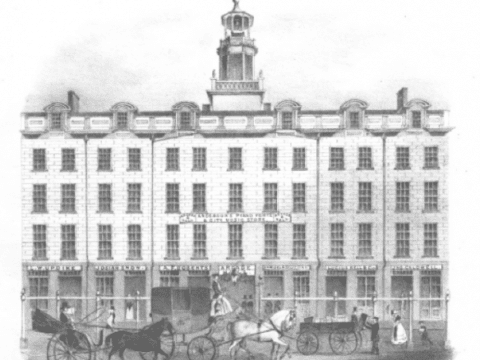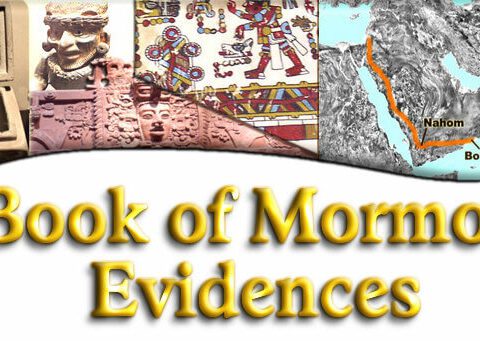In my previous post on Alma 7:11 (I wonder if that was the name of an ancient Nephite convenience store?), one commenter, MahNahvu pointed to possible “evidence of a Hebrew original in the Psalm of Nephi, 2 Ne 4:16-35.” His insightful comments for verses 21-22 are posted at http://feastupontheword.org/2_Ne_4%3A21-25. Thanks, MahNahvu! FeastUponTheWord.org is an interesting site, like a Wikipedia for scriptural commentary.
His comments reminded me of the many subtle ancient Semitic influences one can find in the Book of Mormon. Sometimes aspects of the Book of Mormon that seem weak or even ridiculous actually become subtle evidences for authenticity when someone with knowledge of Hebrew or ancient Semitic practices deals with the issue. On the other hand, there are cases where someone with knowledge of Hebrew appears to expose a flaw in the text. One such example deals with the name “Alma” itself in the Book of Mormon.
The name Alma for years was derided as a gaffe in the Book of Mormon, since “everyone knows” it is a female name in Latin and Spanish, not a Jewish man’s name. Then a discovery in Israel apparently showed that it was a real Jewish man’s name from roughly the time of Lehi. While this discovery ought to give the critics food for thought, it has ignored or rapidly dismissed, and more recently attacked by some critics having a little knowledge of Hebrew. For example, one critic e-mailed the following question: “Why do pro-LDS apologists cite names such as ‘Alma’ as evidence? In Hebrew, vowels are omitted so any ‘new discovery’ is just a coincidence (Alma= LM).”
Critics tend to always dismiss any evidence as just coincidence, but in this case, as with many others, there is little basis for the dismissal. The critic implies that all we have for the name Alma is two consonants that could just as easily be pronounced Lame-o, Elmo, Alum, Oleomo, Oily Moe, and so forth. This is not the case. The name in the ancient Jewish document is actually spelled with four letters, beginning with an aleph. The name appears in two forms that differ in the final letter, but “Alma” fits both.
For scholars of Hebrew, there is good evidence that the name should be “Alma,” which is exactly how the non-LDS scholar, Yigael Yadin, transliterated it. For details, see Paul Hoskisson, “What’s in a Name?,” Journal of Book of Mormon Studies, Vol. 7, No. 1, 1998, pp. 72-73, which shows a color photograph (in the printed publication) of the document that has the name Alma twice. John Tvedtnes also discussed the name Alma in a well-received presentation to other non-LDS scholars, “Hebrew Names in the Book of Mormon,” where he noted that in addition being found as a male name in one the Bar Kochba documents, it is also found as a medieval place name in Eretz Israel and as a personal male name from Ebla. (Also see “Book of Mormon Names Attested in Ancient Hebrew Inscriptions” by John Tvedtnes, John Gee, and Matthew Roper.)
Are you aware of any critics that have provided a meaningful explanation of the numerous Hebrew influences found among Book of Mormon names? Was it just luck that Joseph could take a female name, call it an ancient Hebrew man’s name, and have that verified over a hundred years later? No, the name Alma doesn’t prove anything, but taken with all the other evidences of Hebraisms and Semitic influence, it seems inadequate to ascribe the origins of the Book of Mormon to mere fraud and dumb luck. Now if Ethan Smith or Solomon Spaulding had used the male name Alma and other names in the Book of Mormon, the case for plagiarism might be much stronger.











Michael Quinn addresses this topic and deals with Joseph’s Hebrew influences quite extensively in “Early Mormonism and the Magic World View”…later in his career if I’m not mistaken he hired a Hebrew scholar (Josiah Sexias -sp?) to add to his repertoire of Hebraic references…
James,
Correlation does not equal causation. Some mere dabblings of Hebrew in the folk magic culture of New England do not equate linguistic competence. Quinn does refer to how some made magic circles with swords that had Hebrew letters on them (YHWH). Given this and some other peripheral querks of the magic culture, Joseph’s exposure to Hebrew was extremely limited. Since most people in New England did not read or speak Hebrew, it would have been illogical for their magic culture to be based on it. The most one can say is that Joseph knew about Hebrew letters.
This is very different from writing in poetic verse and employing Hebrew puns.
And even if that famed frontier scholar Joseph Smith had studied Hebrew extensively before publishing the Book of Mormon, nothing available to the scholarly world in 1830 (as far as I am aware) would have hinted that Alma was an authentic man’s name in ancient Israel. Relatively few of the most interesting evidences of ancient Semitic origins in the text could have been faked in the Book of Mormon based on what Joseph Smith could have learned by 1830.
If the Book of Mormon were written by Joseph Smith drawing upon what was known in his day, we might have expected the sword of Laban to have prominent Hebrew letters on it, and we might expect to find many other details from Adair, von Humboldt, Josiah Priest, Ethan Smith, etc., thrown into the text to add plausibility, but these smoking guns have fired nothing but blanks into the pages of the Book of Mormon. Hmm, that’s an awkward metaphor, but I hope you get my point. If the Book were a fraud designed to resonate with the knowledge of scholars of the day, Joseph missed opportunity after opportunity to strengthen his text. Instead, we are left with broad, vauge parallels of the kind that point to chance rather than plagiarism as the source.
So where did Joseph Smith get the idea of Alma as a Jewish man’s name?
From “Book of Mormon Authorship” by Vernal Holley, 1989
“While the Book of Mormon contains much more religious material than the Spaulding text, the outlines of the two stories are essentially the same. Each record was found in exactly the same way; was written for the same purpose; tells the story of the same ancient American inhabitants; has the same sea voyage; has light- and dark-skinned people; tells of the same arts and sciences; has a comparable Christian theology; presents a white Godperson; involves the use of seer stones; and tells of a war of extermination between two nations whose people were once brothers. The final battle in each story is fought on a hill. I also find a remarkable similarity in the literary style of the two works.”
“Alma” also apparently appears as a place name in his Roman Story manuscript.
http://sidneyrigdon.com/vern/Holley1.JPG
You’ve got to be kidding me. Please come up with something better–for your own sake as a debater.
1) Hurlbut, the originator of the tale, admitted to Spaulding’s widow in a letter that the script “did not read as expected” and decided against publishing it. Certainly, Hurlbut concluded, there must be another manuscript Joseph used that was then lost. This is the best he could do? Argument based on conjecture is quite poor.
2)Independent investigators, including Oberlin college president James Fairchild, compared the manuscript found in 1884 with the B.O.M. They “could detect no resemblance between the two, in general or detail.”
3) Worst of all for this argument, how was Joseph supposed to synthesize some random manuscript (which was unpublished at that) into his own personal verbose, all seemingly on the fly? Oliver Cowdery was there the whole time. He never questioned the translation, not once. Don’t you think he might have become a bit tiffy if he saw Joseph flipping through pages as he supposedly “translated by the power and gift of God”? Never mind that Joseph did not meet Sidney until after the B.O.M. was printed (Sidney is supposedly the link to the manuscript–Sidney later called the story “moonshine.”
As to the use of Alma as a name, it’s not the B.O.M.’s mere usage of it that is remarkable. It is how it was used–as a male name. To my knowledge, Spaulding never did that.
Do yourself a favor. Come up with something respectable to argue rather than rolling out the same hackney that any informed Mormon has heard and refuted a gajillion times. I can get you the sources of these quotes, if you’re interested.
That is, supposing you’re not a driveby poster thinking to irk the Mormons…
You need to be careful with this. If it is the document I am thinking of (from the Elephantine archive) then the name is partially reconstructed. In other words, we are guessing (with a great degree of certainty) as to what is there.
Having looked up the article, I see that a Bar-Kokhba letter is being cited, where it is apparently not restored. Sorry for the interruption, please carry on.
Do a search on “Book of Mormon” (with quotes) on Google.
One of Jeff Lindsay’s pages comes up #6.
Congratulations, Jeff.
Jeff–Do a new post! I’m begging you! I know it’s only been three days, but this site is so static I’ve actually gone back to my bad habit of bickering with Kim Siever at “Our Thoughts”–in short, I need help!
LT, dude, you’re addicted. (Welcome to the club.)
I think I’ve now been cured of any desire to go back to Our Thoughts. I always found the atmosphere there to be more tolerant of those who speak against the Church than those who speak for it, but that’s never stood out so starkly as it does now. (If you’re curious, see the threads labeled “Gender” and “Garments.”)
So if a Jew becomes a Mormon they are a JEWMON?